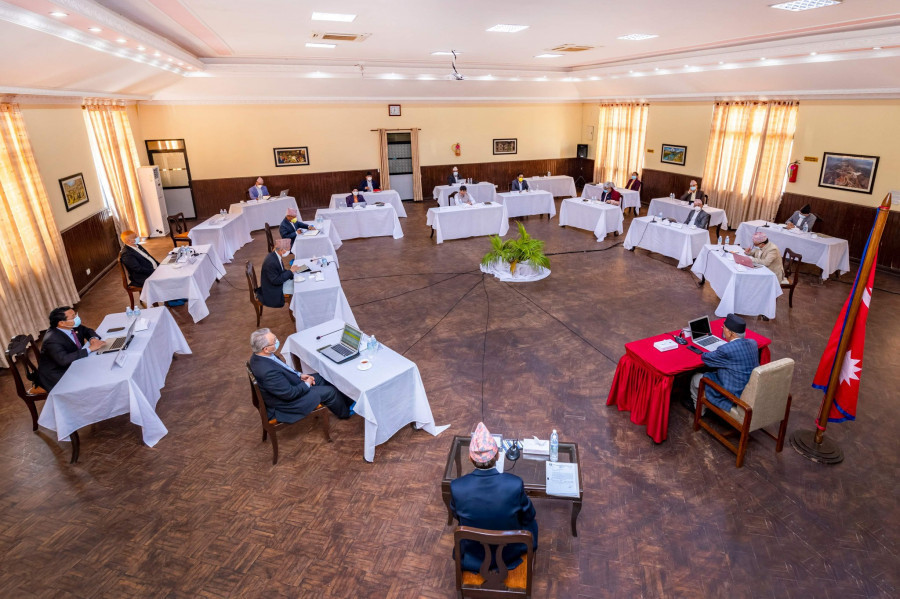National
Local administrations given authority to impose prohibitory orders
Educational institutions cannot hold examinations and those entering Nepal have to stay in quarantine.
Tika R Pradhan
The meeting of the Covid-19 Crisis Management Centre on Sunday has decided to allow the local district administrations to impose prohibitory orders if the number of active cases of Covid-19 exceeds certain thresholds.
Local administrations can impose restrictions in municipalities and rural municipalities if the number of active cases exceeds 200, in sub-metropolises if the cases exceed 500 and in metropolitan cities if the active cases exceed 1,000.
“The local administrations have been allowed to impose prohibitory orders through the decisions of District Covid-19 Crisis Management Centre from Wednesday if the active cases exceed certain numbers,” said Health Minister Hridayesh Tripathi, a member of the CCMC. “We have also decided to halt all examinations from Monday.”
Last week, the Cabinet had decided to allow pre-scheduled examinations if health protocols were followed but the Centre’s meeting on Sunday decided to stop them saying that such people misused the provision and crowds were gathering.
The meeting has also decided to restrict foreigners from entering Nepal's borders and tests, quarantines and isolation centres would be managed for Nepalis entering international borders.
Today’s decisions, according to ministers, are based on measures announced by the Cabinet on Monday to check the second wave of Covid-19 pandemic that includes new variants of the coronavirus.
Earlier on Sunday, after a meeting of the ruling party, Foreign Minister Pradeep Gyawali had said the government was not thinking of a nationwide lockdown but local administrations could impose restrictions at their places.
“We are just trying to stand up economically from the loss we suffered in last year’s lockdown. So we cannot afford it anymore,” Gyawali told reporters.
The extended meeting of Covid-19 Crisis Management Centre held on Saturday at the prime minister’s residence in which Prime Minister KP Sharma Oli was also present had decided to strictly implement the order issued by the government on Monday.
On Monday, the government had issued an order with a slew of measures from defining capacity in public transport to restriction in gatherings of more than 25 people.
After attending crowded programmes, including the inauguration of Dharahara on Saturday, Prime Minister KP Sharma Oli had attended the meeting of the Centre besides the heads of the security bodies and secretaries of different ministries.
“We have decided to implement the April 19 order issued by the government and make necessary arrangements to ensure proper treatment of the affected people,” said Health Minister Tripathi. “But if the situation continues to worsen, there won’t be any alternative to lockdown.”
Tripathi said it is the responsibility of the people as well to follow the health and safety protocols.
When the new UK variant of coronavirus was detected in Nepal in mid-January, leaders of the ruling Nepal Communist Party were busy making indecent comments against each other—standing for and against the House dissolution.
Around a month earlier when the virus count had crossed the 300 mark from the usual 100 infections a day, the Health Ministry had called for strict restrictions in gatherings of more than five people. Even their suggestions to close all educational institutions, including schools and colleges, were not followed up on for a few weeks.
“Today what we are facing is the result of mass meetings held by political parties and their factions. The impact of the virus spread in India is yet to come,” said Dr Jageswor Gautam, spokesperson of the Health Ministry.
On Sunday, Nepal recorded 3,032 new cases. This is for the first time positive cases surpassed 3,000 since November 5.
The Health Ministry said that 28 deaths have been recorded in the last 24 hours, pushing the toll to 3,164. Active cases stand at 19,382 and the total number of cases has reached 300,119.
According to the Health Ministry, in the worst-case scenario, there will be 800,000 cases, 15,000 people will need ICU and ventilators and 45,000 will require high flow oxygen by mid-July.




 5.27°C Kathmandu
5.27°C Kathmandu








%20(1).jpg&w=300&height=200)





